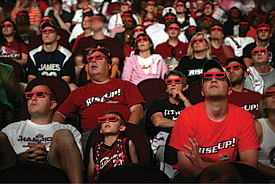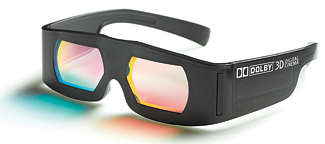3D Live and Otherwise
LOS ANGELES
Even before Hannah Montana's 3D movie ruled the box office this summer, there was the dream of new 3D revenue streams down the theatrical-to-home progression.
Philips' 3D WOW vx42- inch TV got an ovation from a standing-room-only audience at the International CES/hometech show in May. Hyundai, Mitsubishi and Samsung models currently demo the 3D trailer for Missy Elliott's February concert to illustrate 3D's smaller screen potential. And many predict a big 3D turnout at CES2009.
"There are quite a few companies who believe that 3D is the next level of immersive experience now that HDTV has raised the resolution and audio capabilities for video consumption," said Brian Markwalter, vice president, Technology and Standards for the Consumer Electronics Association. "Investments are being made in R&D to overcome the historical hurdles to 3D use on a wider scale—it is safe to say we will have a vibrant 3D marketplace."

SIMPLE & COST-FRIENDLY
3D was showcased at the 2008 NAB Show as well as IBC2008, which highlighted a live "historic" interview with DreamWorks Animation CEO Jeffrey Katzenberg captured on multi-camera stereoscopic equipment in Los Angeles and instantaneously delivered to Amsterdam's RAI Auditorium. Los Angeles-based 3Ality Digital did the production, while U.K.-based satellite service company Arqiva supplied transmission. 3Ality Digital founder and CEO Steven Schklair said the purpose of the demonstration was to show broadcasters how simple the technology is—and how cost-friendly.
"There's not one piece in the chain from the broadcaster's side that needs to be changed from their HD infrastructure," said Schklair. "We are now involved in a number of television-based projects."
Schklair declined to provide details, but emphasized that the productions "are active, moving forward and actually being shot."
Schklair had no hard estimate on the incremental production cost of using 3D, stating it depended on the content. Although Schklair noted that 10-15 percent higher costs was generally accepted by Hollywood, he added that 3Ality came closer to 6-7 percent estimates for specific 3D upgrades to 2D projects. He also indicated that although there was more equipment per camera position, one could very well use a lot less positions because shots are held longer.
As for his choice of subject for IBC2008—an interview versus a spectacle—Schklair is convinced 3D enhances everything.
"It just adds to the experience," he said, comparing the phenomenon to surround sound audio and color TV. "It feels more present."
Mark Cuban, an early proponent of HDTV and chairman of HDNet also trumpets 3D's potential. "3D will be a mainstay of the future of digital media," Cuban told the FCC at its "Future of Digital Media" event in July. He noted that his company was considering building a truck dedicated to live 3D programming. "The technology will advance, decline in price, and applications will be developed that will expand the use of 3D from entertainment to corporate to medical and personal and more," Cuban said.
WHY NOW?
Stereoscopic moving images appeared as early as 1922, when New Yorkers paid to see a 3D version of the film "Mars," using Lauren Hammonds' Teleview system. Polarized light projection debuted in a 15-minute film at the Chrysler exhibit at the 1939 World's Fair. Hollywood films and James Butterfield's broadcast of stereo images viewed with prism glasses reawakened interest in the early 1950s. The revival of interest every few years thereafter has been based on the commonly held belief that people will pay more to see something in 3D. This time new technology also makes the process cheaper and easier.

Dolby 3D glasses are durable, lightweight, high-performance devices designed to be used hundreds of times. "The ability to convert digital cinema projection systems to 3D is relatively inexpensive," said technology guru Mark Schubin, who worked on 3D coverage for the Rolling Stones "Steel Wheels" tour.
AutoStereo functions have also made today's acquisition equipment easier to operate, said 3D innovator Vince Pace, who helms PACE, a Burbank-based company designer of professional imaging equipment. These functions could, for example, automatically calibrate the intraocular distance to the subject matter for a specific field of view, and adjust the camera for the best 3D results.
In addition to custom-designing 3D acquisition technology based on Sony's HDC-950 camera, PACE has also introduced an auto-balancing component for Steadicam units and remote heads to counteract 3D camera displacement during the shooting process. And it provided the first 3D mobile unit for this summer's "Hannah Montana" shoot to house an expanding variety of 3D cameras; the unit recently added a 3D multivideo wall.
Improvements in acquisition technology to better mimic human eye movement to a point of interest (referred to as "dynamic convergence") and better shot selection and pacing have also helped lift the medium's reputation for inducing eye strain, Pace said, as have improvements (like ghost-busting) in post production.
"Both Avid and Quantel are demonstrating tools that have strong 3D capabilities," he said. "Evertz, Fujinon, Sony, and Telecast should also be credited for moving this technology forward."
Although Pace conceded that "bigger is always better," he said, that the "wow, it's right there!" feeling can be transmitted from a 50-inch screen or a 40-foot screen.
"I would like to see the entertainment industry go to 'entertainment glasses'—it would be really fantastic if you could use those same [cinema] glasses at home on your television set," he said, assuming there were affordable display options and enough compelling content to warrant the purchase. "The broadcast market is certainly there already."
LIVE BROADCASTS
Pace was involved in all three well-received National Basketball Association games viewed live in 3D over the past 19 months.
The first occurred on Feb. 18, 2007 at the NBA All-Star game, where 3D content was transmitted real time via fiber from Las Vegas' Thomas & Mack Center to the Mandalay Bay Hotel, three miles away. Next was the second game of the 2007 NBA finals, the June 10 match between the Cleveland Cavaliers and San Antonio Spurs shown in 3D to 14,000 fans at Cleveland's Quicken Loans Arena, thousands of miles from Texas. Mark Cuban hosted a 3D showing in Dallas' Landmark Theatre of the March 25, 2008 game between his Dallas Mavericks and the Los Angeles Clippers, transmitted in real time via satellite.
Although he declined to release specifics, Mike Rokosa, vice president of engineering For NBA Entertainment, said his organization is enthusiastic about 3D's potential.
"We're actively chasing 3D as a technology—it's something we have a lot of high hopes for," he said. "Anytime the action comes to or from the camera and it's unrehearsed it's spectacular."
STANDARDS
Several industry organizations recently announced their intentions to develop standards for 3D for production and consumer electronics.
In July, the Society of Motion Picture and Television Engineers said it was establishing a task force to "define the parameters of a stereoscopic 3-D mastering standard for content viewed in the home." The 3-D Home Display Formats Task Force held its inaugural meeting Aug. 19 at the University of Southern California. Its first task was to watch demonstrations of various 3-D technologies, then, over the next six months, define "the issues and challenges, minimum standards and evaluation criteria for the future SMPTE 3-D standards," the association said in a statement. Seven companies were invited to demonstrate their technologies: DDD, Dolby, Philips, RealD, Sensio, TDVision Systems and Texas Instruments.
Last month, the Consumer Electronics Association announced the formation of its 3D Video Discovery Group, which will investigate the need for standards to address delivery and presentation of 3D video in the home. Its first meeting will take place at the Technology & Standards Forum in Las Vegas, Oct. 22.
Get the TV Tech Newsletter
The professional video industry's #1 source for news, trends and product and tech information. Sign up below.
